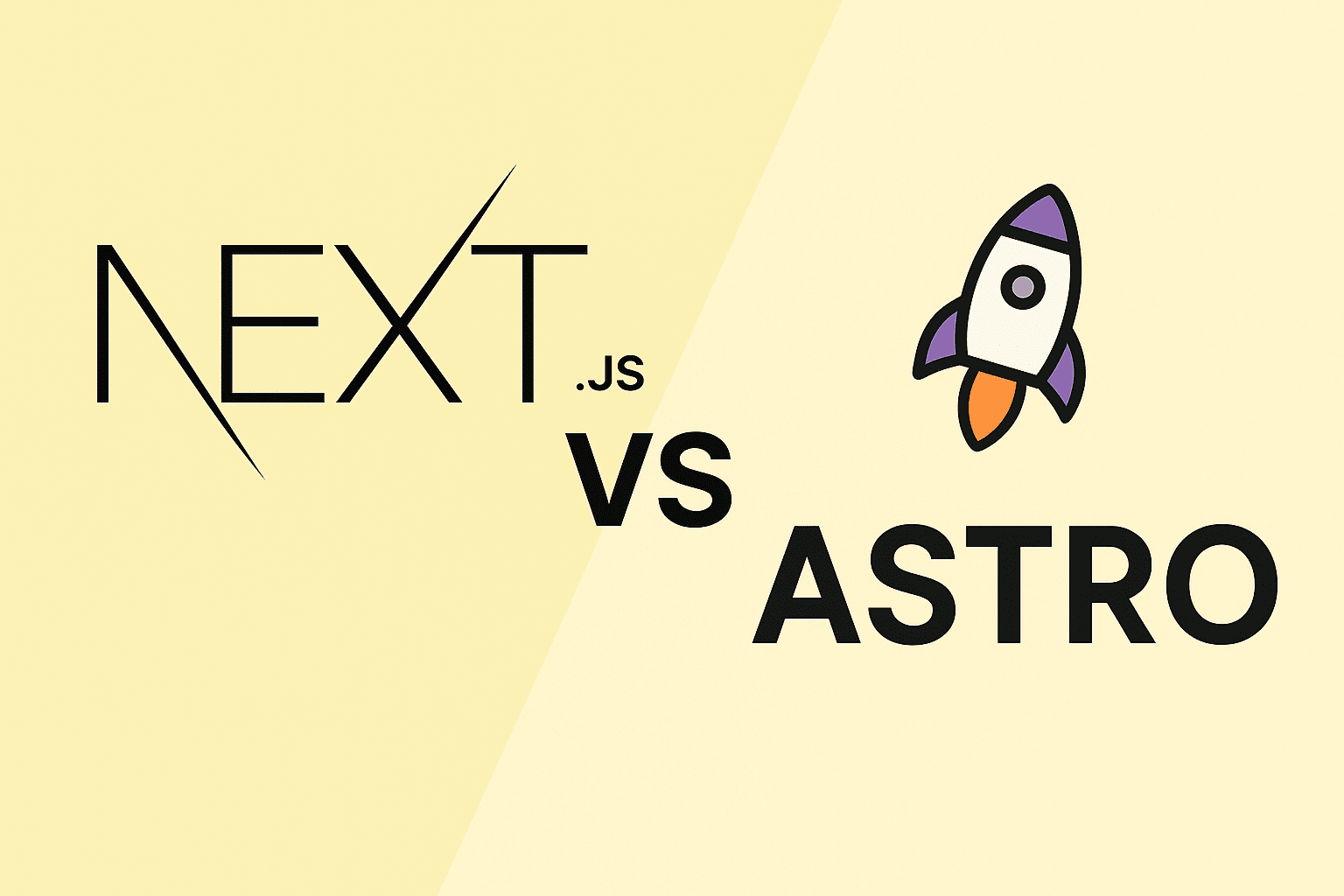Next.js vs Astro: Which JavaScript Framework is Best for Your Project in 2025?
As web development continues to evolve, developers are faced with a growing number of frameworks that promise faster performance, better SEO, and simpler development workflows. Among the top contenders in 2025 are Next.js and Astro — two powerful frameworks that approach website and application building in very different ways.
In this in-depth comparison, we’ll explore Next.js vs Astro, diving into their benefits, drawbacks, use cases, and ultimately help you decide which framework is best for your next web project.
What is Next.js?
Next.js is a React-based framework developed by Vercel. It is designed to build full-stack applications with powerful capabilities like server-side rendering (SSR), static site generation (SSG), API routes, and more.
Benefits of Next.js
- Full-stack capabilities: Built-in API routes and middleware make it easy to build back-end functionality without leaving the frontend stack.
- Hybrid rendering: Supports SSR, SSG, and Incremental Static Regeneration (ISR).
- Massive ecosystem: Built on React, which means access to a huge number of libraries, tools, and community support.
- SEO-friendly: With SSR and meta control, Next.js is optimized for search engine indexing.
- Edge-ready: Designed to work seamlessly with edge networks for ultra-fast delivery.
Drawbacks of Next.js
- JavaScript-heavy: Ships a lot of client-side JavaScript, which can affect performance if not managed well.
- Overkill for simple sites: Best for complex apps, but too bulky for static content-heavy sites.
- Learning curve: Requires understanding of React and full-stack concepts to fully utilize its features.
What is Astro?
Astro s a modern static site builder that focuses on shipping less JavaScript by default. It’s built for speed and content-focused websites, supporting multiple frontend frameworks like React, Vue, Svelte, and even plain HTML.
Benefits of Astro
- Zero JS by default: Astro ships minimal JavaScript to the client unless needed — making it blazing fast.
- Islands architecture: Only interactive components load JS, improving Core Web Vitals scores significantly.
- Framework agnostic: Use React, Svelte, Vue, Solid, or plain HTML all in the same project.
- Perfect for content sites: Ideal for blogs, marketing pages, documentation, and static sites.
- Built-in MDX/Markdown support: Effortlessly write and render content with Markdown and MDX.
Drawbacks of Astro
- Not ideal for complex web apps: Astro shines with static content, but may not be suitable for full-scale dynamic apps.
- Limited full-stack features: Unlike Next.js, Astro doesn’t have native API routes or serverless functions (though integrations exist).
- Smaller ecosystem: While growing fast, Astro’s ecosystem is still smaller compared to React/Next.js.
Next.js vs Astro: Side-by-Side Comparison
| Feature | Next.js | Astro |
|---|---|---|
| Rendering | SSR, SSG, ISR, Client-side | Static by default, SSR optional |
| Use Case | Web apps, dashboards, SPAs | Blogs, landing pages, content sites |
| Performance | Good (can be heavy with JS) | Excellent (minimal JS by default) |
| Framework Dependency | React only | Supports multiple frameworks |
| Full-stack Features | Yes (API routes, middleware) | No (needs integrations or adapters) |
| Learning Curve | Moderate to High | Beginner-friendly |
| JavaScript Output | Heavy | Very light |
| MDX/Markdown Support | Supported (with config) | First-class support |
When to Use Next.js
Choose Next.js if:
- You’re building a dynamic web application, SaaS platform, or dashboard.
- You need API routes, server-side logic, or authentication.
- You want a React-based full-stack framework.
- Your project demands hybrid rendering (some pages static, others server-rendered).
When to Use Astro
Choose Astro if:
- You’re building a static website, marketing site, blog, or documentation.
- You prioritize performance and Core Web Vitals.
- You want to mix frontend frameworks like Svelte, Vue, and React.
- You want a simple, fast, and SEO-optimized site with minimal JavaScript.
Performance Comparison (Lighthouse Scores)
| Metric | Astro (static site) | Next.js (basic SSR site) |
|---|---|---|
| Performance | 95–100 | 80–95 |
| Accessibility | 95–100 | 90–100 |
| SEO | 100 | 95–100 |
| JS Payload Size | ~10-30KB | ~100-300KB |
Note: Actual scores vary based on implementation, but Astro generally delivers better performance out of the box.
Which Framework is Best in 2025?
Best for Web Apps: Next.js
If your project is a full-featured web application, you can’t go wrong with Next.js. It offers a robust set of tools for routing, data fetching, dynamic content, and API integration. It’s an industry standard and widely supported.
Best for Static Sites: Astro
If you’re building a fast, content-rich website with minimal interactivity — Astro is a game-changer. You’ll get incredible performance, simple development, and top-notch SEO without dealing with heavy JS frameworks.
Final Thoughts
Both Next.js and Astro are modern, capable frameworks, but they serve different purposes. Understanding the type of website or app you’re building will help determine the best fit.
In 2025, Astro is gaining rapid adoption for static and content-focused sites, while Next.js remains the go-to for full-scale web applications.
Choose wisely based on performance needs, complexity, and development goals.





Post Comment